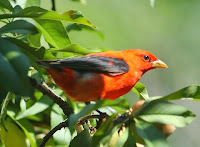 |
| House Finch |
 |
| Scarlet Tanager |
As people are living closer together, more and
more products are being made or adapted for use in small spaces like balconies,
patios and “postage stamp” courtyards. This is vital since bird habitat is disappearing at an alarming rate.
 |
| Wood Thrush |
Many feeders can be mounted on windows, using
heavy-duty suction cups. There is almost no danger of birds flying into a
window with this type of feeder. Reason: the bird is in a slow ”landing pattern” when he’s within two feet of
a feeder, so he’s alert to the surroundings. The real danger zone is if a
feeder is about 2 to 6 feet from a
window. At this distance a bird, circling the feeder (and concentrating on its
location) isn’t paying attention to a nearby window. To be extra-cautious,
stick some sort of ribbon or decal on the glass.
Seed residue can be a problem. To avoid this entirely, use a variety of seed that has had the outside hull removed. Since the birds don’t have to remove the hull from the seed, there’s no hull to fall to the ground. Or to fall on your balcony. The goal, however, is to entice the birds to eat every last seed.
Of course, if a seed is fresh (even if the hull is left on), any that falls to the ground will likely be eaten by ground-feeding birds – like Cardinals. Thrashers and Doves. So, even if the price is a bit more, get the seed that’s freshest from the mill. More of it gets eaten and less of it winds up beneath the feeder. If you can clean up the hulls beneath a feeder, go ahead and buy the less-expensive seed with hulls.
Seed that’s blended especially for our
 |
| Violet-crowned hummer |
 |
| Rose-breasted Grosbeak |

